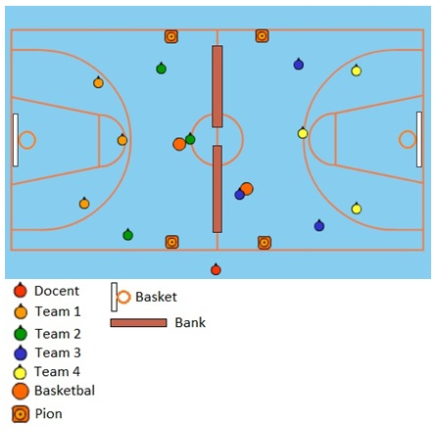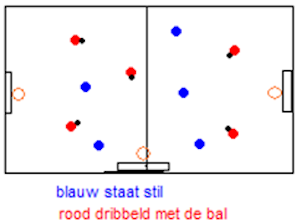Basketball drills for technique passing
- ...prepare for the ball to come.
- Eyes on the approaching ball.
- The arms are stretched out towards the ball;
- the wrists are slightly bent backwards;
- the fingers are spread and point upwards;
- The body reaches slightly forward.
- At the moment of ball contact, the fingertips touch the ball first;
- the thumbs and slightly the index fingers are behind the ball,
- so that the ball cannot shoot through.
- the speed of the ball is slowed down by bending the arms.
- The ball comes to rest in front of the diaphragm.
- Especially with 'hard' passes, it is useful to place one foot in front of the other while catching.
- The feet are in a small scissor or parallel position.
- Knees slightly bent; torso slightly forward.
- bodyweight above both feet.
- the ball is held at chest level with the fingertips; thumbs behind the ball.
- the elbows point backwards and are not too close to the body. eyes directed at the goal.
- By extending the arms and the back leg, the ball is pushed away and guided for as long as possible; the ball leaves the hands via the fingertips.
- At the end of the action, the palms point outwards and the thumbs downwards;
- this is caused by the forceful folding of the wrists.
- The body weight is transferred to the front foot through the entire action.
- The pass is often supported by a step with the front leg in the direction of the goal.
- The chest pass can also be performed in a sideways direction; pivoting in the direction of the goal is necessary for this.
- feet in parallel position; ball in both hands in front of chest.
- eyes focused on the goal.
- Step with the left foot in the direction of the pass,
- so that the left side of the body comes in front (turning in);
- At the same time, the ball is brought behind the head with both hands;
- the body weight rests on the back leg.
- The elbow is under the ball;
- the angle between the upper and lower arm is about 90 degrees;
- the fingers of the throwing hand are spread.
- next: turn your hips and trunk to the left;
- the left hand will lose contact with the ball and is held horizontally to protect the action;
- the elbow is bent.
- The right arm swings in a straight line past the head in the direction of the goal; the movement ends with the wrist being folded over.
- The right arm swings in a straight line along the head towards the target; the movement ends with the flick of the wrist; the ball is pointed after by the throwing arm,
- while the wrist hangs down in a relaxed position.
- During the action, the body weight is transferred to the front foot.
- free play on 1 or 2 baskets, depending on the number of players.
- PURPOSE: Quick passing, cutting, helpside, ballside, boxing-out.
- First team at 5.
- Loser push-ups 6.
- Depending on the number of balls.
- Pairs or alone.
- In singles.
- Start at your position, dribble to opposite side of basket.
- Set or jump shot from your position (guard, forward, center).
- Up to 8 hits.
- In pairs.
- Start from position, pass to opposite basket.
- Last pass must be good so that shooter in jumpshot is ready for his/her shot.
- Up to 4 touches per player!!!!!
- Losers, 1x back and forth slides in width.8 hoops/pawns for shooting positions.
- 2 rows of which 1 row has the ball.
- Passes to the middle line from the middle line 1 vs 1.
- When passing, make sure the persons keep running straight and don't go sideways.
- free play on 1 or 2 baskets,
- depending on the number of players.
- NO dribbles only passing.
- The teacher divides the room into two squares by placing benches on the centerline of the room.
- Then the teacher makes 2 squares with pawns to catch up the right of attack.
- During this game the rulebook is used.
- See module basketball for this guide.
- The teacher divides the students into teams of 3, possibly with a substitute.
- See the tables at the bottom of the lesson preparation for the game schedules.
- The intention is that the team that has the ball (on the map team 2 & 3) try to score.
- To be able to score, the team must first get the right of attack.
- They get this right of attack when they arrive with the ball in the area of the pawns.
- From now on the team may score.
- They do this by shooting the ball into the basket.
- The other team must try to take the ball away from them.
- When this happens, the teams swap roles and the new team with the ball has to get the right of attack and try to score.

- There are rows of players on both sidelines.
- The front player of each row has a basketball.
- These players dribble to the sideline on the other side and play the ball with a bounce pass to the second player in the row who is now automatically in front.
- The first player closes in behind and the second player now dribbles across.
- The players practise the overhead pass (with 2 hands, from above the head) and vary the distance
- Players stand in a circle with 1 player in the middle.
- One player starts and throws the ball with a chest pass to the player in the middle.
- Then the first player runs after the ball to the middle.
- The player in the middle throws the ball to the next player in the circle and then runs after them etc.
- The players stand in a circle and pass the ball to each other.
- They are free to choose who they throw to and which pass variant they use.
- To make the exercise more difficult more basketballs can be used.
- Two players throw the ball to each other, the ball may bounce.
- To make it more difficult the bouncing can be omitted.
- Also vary the distance.
- The players stand in a circle and throw the ball to each other.
- They are not allowed to touch the ground.
- Try this with a player in the middle who is trying to intercept.
- If the ball is intercepted, the player who threw the ball stands in the middle.
- The children stand in a large circle.
- There are several basketballs in the game.
- The children with the ball bounce the ball as fast as possible to a classmate or group member, while calling his or her name.
- This is recommended for children's camps (great outdoors!) or sports days, where children can learn each other's names and learn to catch the ball.
- Players who do not bounce the ball well, do not catch the ball or call out the wrong name, step out of the circle and do not participate for a while.
- As fewer and fewer players remain, the remaining players bounce more and more balls.
- Continue, until only one or two players remain.
- They have won.
- Half of the basketball players have a ball.
- These basketball players dribble all over the room.
- On the whistle they pass the ball to someone they first made eye contact with.
- The pass they use to do so is up to them.
- Choose the pass that is best in the situation.
- If you are close to the ball, do not pass.









